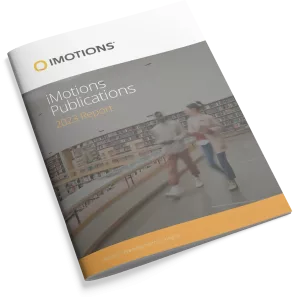-
A Preliminary Investigation towards the Development of an Emotion-Aware Partner Agent for Training Control
Abstract: Simulator-based training platforms have become increasingly popular on the grounds of their potential to facilitate skill acquisition within safe and controlled environments. However, current technology is limited in its ability to adapt to individual trainees. Tailoring is in fact typically based on recorded simulation inputs and outputs, or relies on costly and time-consuming trainer-driven […] -
The impact of seasonal colour change in planting on patients with psychotic disorders using biosensors
Abstract: The beneficial effect of nature on patients with mental disorders is of particular importance. There has been an increase in mental illnesses in recent years, but research on the design of healing gardens for mental and behavioural disorders remains limited. This paper is part of a wider study that aims to investigate the effect […] -
Integrating Non-Invasive Neuroimaging and Computer Log Data to Improve Understanding of Cognitive Processes
Abstract: As non-invasive neuroimaging techniques become less expensive and more portable, we have the capability to monitor brain activity during various computer activities. This provides an opportunity to integrate brain data with computer log data to develop models of cognitive processes. These models can be used to continually assess an individual’s changing cognitive state and […] -
The Effect of Whole-Body Haptic Feedback on Driver’s Perception in Negotiating a Curve
Abstract: It remains uncertain regarding the safety of driving in autonomous vehicles that, after a long, passive control and inattention to the driving situation, how the drivers will be effectively informed to take-over the control in emergency. In particular, the active role of vehicle force feedback on the driver’s risk perception on curves has not been […] -
Automatic Recognition of Posed Facial Expression of Emotion in Individuals with Autism Spectrum Disorder
Abstract: Facial expression is impaired in autism spectrum disorder (ASD), but rarely systematically studied. We focus on the ability of individuals with ASD to produce facial expressions of emotions in response to a verbal prompt. We used the Janssen Autism Knowledge Engine (JAKE®), including automated facial expression analysis software (FACET) to measure facial expressions in individuals […] -
Copycat of dynamic facial expressions: Superior volitional motor control for expressions of disgust
Abstract: In social situations facial expressions are often strategically employed. Despite the many research on motor control of limb movements, little is known about the control over facial expressions. Using a response-priming task, we investigated motor control over three facial expressions, smiles, disgust and emotionally neutral jaw drops. Prime stimuli consisted of videos of a facial […] -
Visual Exploration in Autism Spectrum Disorder: Exploring Age Differences and Dynamic Features Using Recurrence Quantification Analysis
Abstract: Eye‐tracking studies have demonstrated that individuals with autism spectrum disorder sometimes show differences in attention and gaze patterns. This includes preference for certain nonsocial objects, heightened attention to detail, and more difficulty with attention shifting and disengagement, which may be associated with restricted and repetitive behaviors. This study utilized a visual exploration task and replicates […] -
Assessing a maritime service website prototype in a ship bridge simulator: navigators’ experiences and perceptions of novel e-Navigation solutions
Abstract: The aim of this study was to assess proof of concept and usability of a maritime service website prototype in a full-mission ship bridge simulator through Swedish mariners’ experiences and perceptions. This test was part of the European Commission’s EfficienSea2 project for e-navigation. The prototype was intended as an aid to existing standard systems […] -
A Mobile Health Intervention for HIV Prevention Among Racially and Ethnically Diverse Young Men: Usability Evaluation
Background: Mobile health (mHealth) apps have the potential to be a useful mode of delivering HIV prevention information, particularly for young men (13-24 years) who account for 21% of new HIV diagnoses in the United States. We translated an existing evidence-based, face-to-face HIV prevention curriculum into a portable platform and developed a mobile Web app: MyPEEPS […] -
Automotive Emotions: An Investigation of Their Natures, Frequencies of Occurrence and Causes
Abstract: Technological and sociological developments in the automotive sector are shifting the focus of design towards developing a better understanding of driver needs, desires and emotions. Human-centred design methods are being more frequently applied to automotive research, including the use of systems to detect human emotions in real-time. One method for a non-contact measurement of […]
Research Report 2024
In-depth look at the scientific landscape as powered by iMotions software, showcasing groundbreaking research and the impact of our tools in various scientific and industrial fields.

iMotions Science Resources
Looking for white papers, validation reports or research show casing iMotions Multimodal capabilities?
Share Your Research

850+ universities worldwide with an iMotions human behavior lab
73 of the top 100 highest ranked universities
710+ published research papers using iMotions
iMotions is used for some of the most interesting human behavior research studies carried out by top researchers around the world. Contact us to have your publication featured here.
The authors of these publications have used iMotions as a software tool within their research.
“Software should be cited on the same basis as any other research product such as a paper or a book; that is, authors should cite the appropriate set of software products just as they cite the appropriate set of papers” (Katz et al., 2020).
We therefore encourage you to cite the use of iMotions where appropriate.
How to cite iMotions
APA
iMotions (10), iMotions A/S, Copenhagen, Denmark, (2024).
Note: adjust the version and year where relevant.
5 Most Popular Blogs
Learn How to Conduct Human Behavior Research with iMotions
Publications
Read publications made possible with iMotions
Blog
Get inspired and learn more from our expert content writers
Newsletter
A monthly close up of latest product and research news

